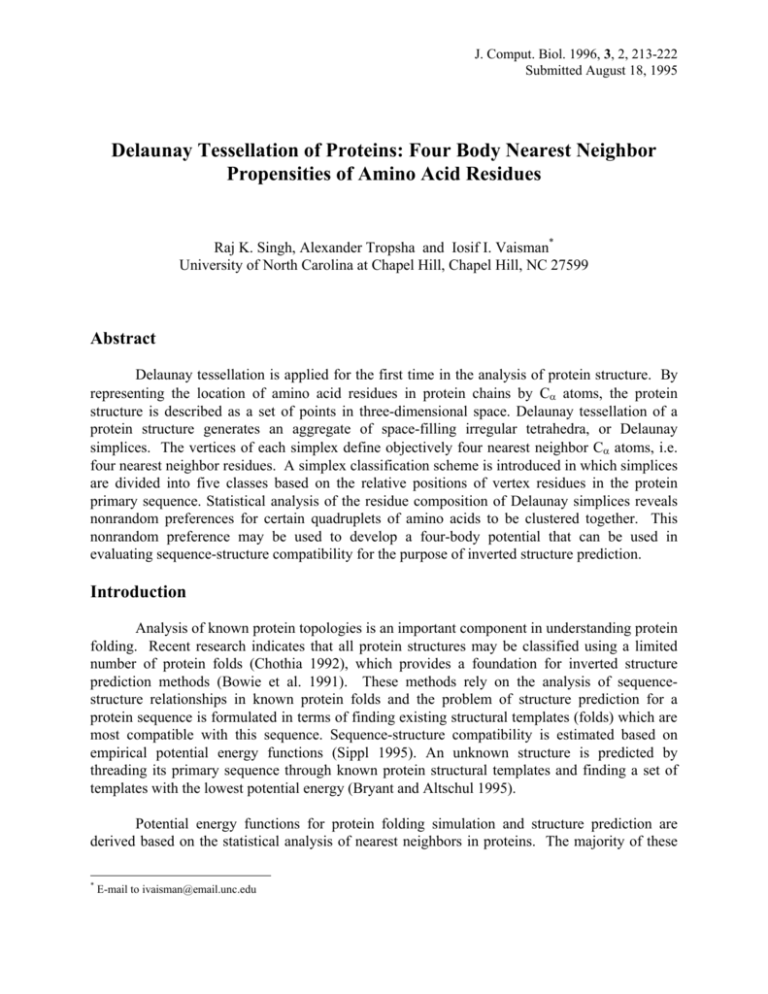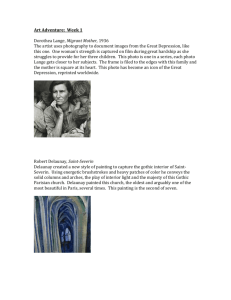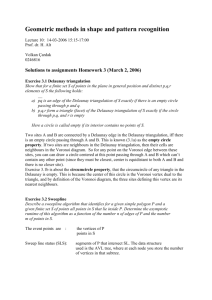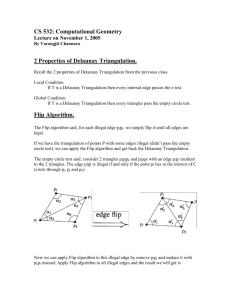Delaunay Tessellation of Proteins
advertisement

J. Comput. Biol. 1996, 3, 2, 213-222
Submitted August 18, 1995
Delaunay Tessellation of Proteins: Four Body Nearest Neighbor
Propensities of Amino Acid Residues
Raj K. Singh, Alexander Tropsha and Iosif I. Vaisman*
University of North Carolina at Chapel Hill, Chapel Hill, NC 27599
Abstract
Delaunay tessellation is applied for the first time in the analysis of protein structure. By
representing the location of amino acid residues in protein chains by Cα atoms, the protein
structure is described as a set of points in three-dimensional space. Delaunay tessellation of a
protein structure generates an aggregate of space-filling irregular tetrahedra, or Delaunay
simplices. The vertices of each simplex define objectively four nearest neighbor Cα atoms, i.e.
four nearest neighbor residues. A simplex classification scheme is introduced in which simplices
are divided into five classes based on the relative positions of vertex residues in the protein
primary sequence. Statistical analysis of the residue composition of Delaunay simplices reveals
nonrandom preferences for certain quadruplets of amino acids to be clustered together. This
nonrandom preference may be used to develop a four-body potential that can be used in
evaluating sequence-structure compatibility for the purpose of inverted structure prediction.
Introduction
Analysis of known protein topologies is an important component in understanding protein
folding. Recent research indicates that all protein structures may be classified using a limited
number of protein folds (Chothia 1992), which provides a foundation for inverted structure
prediction methods (Bowie et al. 1991). These methods rely on the analysis of sequencestructure relationships in known protein folds and the problem of structure prediction for a
protein sequence is formulated in terms of finding existing structural templates (folds) which are
most compatible with this sequence. Sequence-structure compatibility is estimated based on
empirical potential energy functions (Sippl 1995). An unknown structure is predicted by
threading its primary sequence through known protein structural templates and finding a set of
templates with the lowest potential energy (Bryant and Altschul 1995).
Potential energy functions for protein folding simulation and structure prediction are
derived based on the statistical analysis of nearest neighbors in proteins. The majority of these
*
E-mail to ivaisman@email.unc.edu
Delaunay Tessellation of Proteins
Singh, Tropsha, and Vaisman
functions account for pairwise interactions only; however consideration of cooperative
interactions of higher order may improve the quality of structure prediction (see recent reviews
by Johnson et al. 1994, Sippl 1995).
Most methods of protein structure analysis require a definition of nearest neighbor
residues. Existing definitions of nearest neighbors are often based on arbitrary distance criteria
(e.g. separation of Cα atoms by no more than 5.5 Å (Yee et al. 1994), the separation between any
pair of atoms that belong to different residues by less than 2.8 Å (Behe et al. 1991), the separation
in the range of distance from 4.5 to 7.5 Å (Miyazawa and Jernigan 1985) or a set of separations
between various pairs of atoms (Crippen and Maiorov 1994)). Because the definition of a
contact between two residues is not objective, the results of such analyses strongly depend on the
chosen criteria of the contact. Therefore, an objective and robust definition of nearest neighbor
residues in proteins would eliminate one of the dominant sources of ambiguity in methods for
inverted structure prediction and protein folding simulation.
An objective definition of nearest neighbors in three-dimensional space can be obtained
by applying the methods of statistical geometry. The statistical geometry approach for studying
structure of disordered systems was introduced by Bernal (Bernal 1959). He suggested
characterization of structural disorder using statistical analysis of irregular polyhedra obtained by
a specific tessellation in the three-dimensional space. The method, including the design and
implementation of practical algorithms, was further developed by Finney for the case of Voronoi
tessellation (Finney 1970, 1977). Voronoi tessellation partitions the space into convex polytopes
called Voronoi polyhedra. For a molecular system the Voronoi polyhedron is the region of space
around an atom, such that each point of this region is closer to the atom than to any other atom of
the system. A group of four atoms whose Voronoi polyhedra meet at a common vertex forms
another basic topological object called a Delaunay simplex. The procedure for constructing
Voronoi polyhedra and Delaunay simplices in two dimensions is illustrated in Figure 1. The
topological difference between these objects is that the Voronoi polyhedron represents the
environment of individual atoms whereas the
Delaunay simplex represents the ensemble of
neighboring atoms.
Although the Voronoi
polyhedra and the Delaunay simplices are
completely determined by each other, there exists
a significant difference. Whereas the Voronoi
polyhedra may differ topologically (i.e., they may
have different numbers of faces and edges), the
Delaunay simplices are always topologically
equivalent (i.e., in three-dimensional space they
are always tetrahedra). Delaunay tessellation has
been used for structural analysis of various
disordered systems. In most such cases it has
served as a valuable tool for structure description
Figure 1. Voronoi/Delaunay tessellation in 2D space
(Voloshin et al. 1988, Vaisman et al. 1994). In
(Voronoi tessellation - dashed line,
this paper we report for the first time the use of
Delaunay tessellation - solid line).
Delaunay tessellation to define objectively the
2
Delaunay Tessellation of Proteins
Singh, Tropsha, and Vaisman
nearest neighbor residues in 3D protein structures. The most significant feature of Delaunay
tessellation, as compared with other methods of nearest neighbor identification, is that the
number of nearest neighbors in three dimensions is always four, which represents a fundamental
topological property of 3D space. Statistical analysis of the amino acid composition of Delaunay
simplices provides information about spatial propensities of all quadruplets of amino acid
residues to be clustered together in folded protein structures. The empirical four-body contact
potentials derived from this analysis may significantly improve the results of protein structure
prediction.
Methods
Delaunay tessellation is a canonical tessellation of space based on nearest neighbors
(Aurenhammer 1991, Sugihara 1995). A Delaunay tessellation of a set of points is equivalent to
a convex hull of the set in one higher dimension (Barber et al. 1993). For example, to determine
the Delaunay tessellation of a set of points in 3D, we lift the points to a paraboloid and compute
their convex hull in 4D. In general, a (d+1)-dimensional convex hull of a set of points is a
simplicial complex which is represented by its vertices, d-dimensional facets (or simplices), and
lists of adjacent facets.
Since Delaunay tessellation is performed on a set of points, we represent these points
using only the Cα atoms for each residue (it has been shown (Rey 1992) that such reduced
representation of proteins is adequate for accurate restoration to the full atomic backbone
structure). The first step in this process is extracting the set of 3D coordinates of the Cα atoms
from the PDB entry file. Delaunay tessellation of this set of points is then performed using the
program qhull which implements the Quickhull algorithm developed by Barber et al. (Barber et
al. 1993) and is distributed by the University of Minnesota Geometry Center. The Quickhull
algorithm is a variation of the randomized, incremental algorithm of Clarkson and Shor. The
program qhull produces the Delaunay tessellation by computing the convex-hull of this set of
points in four dimensions and is shown to be space and time efficient. The results of the
tessellation are analyzed with the qstat program which computes various geometrical properties
and compositional statistics of Delaunay simplices. Computer software was developed using the
C programming language. Wall clock time required for analyzing a typical protein structure using
an HP-9000/735 workstation is on the order of 10 seconds.
Delaunay tessellation was performed on three representative sets of high-resolution
proteins structures with low primary-sequence identity (Jones et al. 1992, Fischer 1994, and
Hobohm and Sander 1994). The results of our analysis were nearly identical for all three
datasets; the results obtained using the Jones' list are presented in this paper. The dataset
contains 103 protein chains with high crystallographic resolution that do not have apparent
structural similarity and share less than 30% sequence identity. The entries for the proteins in the
Jones’ list were extracted from Brookhaven Protein Data Bank (PDB; Bernstein et al. 1977).
Several PDB entries form the original list, namely 1abp, 1cd4, 1cy3, 1gcr, 1lrd1, 1pcy, 1sn3,
were updated to more recent, 5abp, 3cd4, 2cy3, 4gcr, 1lmb1, 1plc, 2sn3, respectively.
3
Delaunay Tessellation of Proteins
Singh, Tropsha, and Vaisman
Results and discussion
Delaunay tessellation of folded protein structures. The typical results of Delaunay
tessellation of a folded protein are illustrated on Figure 2a for crambin (1crn). The tessellation of
this 46-residue protein generates an aggregate of 192 nonoverlapping, space-filling irregular
tetrahedra (Delaunay simplices). Each Delaunay simplex uniquely defines four nearest neighbor
Cα atoms (vertices of the simplex), i.e., four nearest neighbor amino acid residues.
k
k
j
l
j+1
i+3
j
j
i
i
i+1
i+1
i+2
i
{1-1-1-1} {2-1-1}
Figure 2a: Delaunay tessellation of Crambin
j
{2-2}
i+1
i
i+2
{3-1}
i+1
i
{4}
Figure 2b. Five classes of Delaunay simplices
For the analysis of correlations between the structure and sequence of proteins, we
introduced a classification of simplices based on the relative positions of vertex residues in the
primary sequence. Two residues were defined as distant if they were separated by one or more
residues in the protein primary sequence. Simplices were divided into five nonredundant classes:
class {4}, where all four residues in the simplex are consecutive in the protein primary sequence;
class {3,1}, where three residues are consecutive and the fourth is a distant one; class {2,2},
where two pairs of consecutive residues are separated in the sequence; class {2,1,1}, where two
residues are consecutive, and the other two are distant both from the first two and from each
other; and class {1,1,1,1} where all four residues are distant from each other (Figure 2b). All
five classes usually occur in any particular protein.
We first investigated differences between classes of simplices using geometrical
parameters of tetrahedra such as volume and tetrahedrality. Tetrahedrality is a quantitative
measure of the degree of distortion of the Delaunay simplices from the ideal tetrahedron:
0.4
0.2
0.3
0.2
0.1
0.1
0
0
0
0.1
0.2
0.3
0.4
0
0.5
10
20
30
Volume
Tetrahedrality
Figure 3. Distribution of tetrahedrality and volume (in Å3) of Delaunay simplices
4
40
Delaunay Tessellation of Proteins
Singh, Tropsha, and Vaisman
T =
∑ (l
i
− l j ) 2 / 15 l 2
(1)
i> j
where li is the length of the i-th edge, and l is the mean length of the edges of the given
simplex. Distributions of volume and tetrahedrality for all five classes of simplices is shown in
Figure 3. The sharpest peaks correspond to the simplices of classes {4} and {2,2}. They tend to
have the lowest volume and lowest distortion of tetrahedrality. These results suggest that
tetrahedra of these two classes may occur in regular protein conformations such as α-helices.
In order to verify this hypothesis, we analyzed
the possible correlations between the classes of
0.5
simplices and the conventional secondary structure
0.4
assignment of the constituent residues. The secondary
0.3
structure assignments of individual residues were
0.2
extracted from the headers of PDB files. We have
0.1
considered three conformational states for all residues:
0
helical (H), β-strand (S), and random coil (C). There
{1,1,1,1}
{2,1,1}
{2,2}
{3,1}
{4}
are 15 possible combinations of these three
Figure 4. Classes of Delaunay simplices and
conformational states in sets of four residues. Figure 4
secondary structures
(helices - dots, b-sheets - stripes, coils - empty)
presents the frequency of occurrence of each Delaunay
simplex class where all four residues are found in the
same conformational state. As can be seen from this Figure, there are certain correlations
between secondary structure and simplex class. For example, simplices of classes {4} and {2,2}
are formed mainly by residues in helical conformations. On the other hand, the residues in αhelical conformation almost never form simplices of class {3,1}. Residues in β-sheet
conformation almost never form classes {4} and {1,1,1,1} simplices but frequently form
simplices of classes {2,2} and {3,1}.
0.6
The observed correlations between regular conformations of protein backbone and classes
of tetrahedra (Figure 4) suggest that the ratio of tetrahedra of different classes in a protein may be
characteristic of a protein fold family. We have calculated the relative frequency of occurrence
of tetrahedra of each class in each protein in the Jones’ dataset and plotted the results in Figure 5.
The proteins were sorted in the ascending order of fraction of tetrahedra of class {4}.
Interestingly, the content of simplices of class {3,1} (which are indicative of β-sheet
conformation; cf. Figure 4) decreases with the increase of the content of class {4} simplices.
According to common classifications of protein fold families (Richardson and Richardson 1989,
Orengo 1995), at the top level of hierarchy most proteins can be characterized as all-alpha, allbeta, or alpha/beta. The fold families for the proteins in the Jones’ dataset are also shown in
Figure 5. The results of Figure 4 suggest that proteins having a high content of tetrahedra of
classes {4} and {2,2} (i.e., proteins in the right-most part of the plot of Figure 5) belong to the
family of all-alpha proteins. A comparison between conventional protein fold family assignment
and relative frequency of tetrahedra of different classes confirms this hypothesis (cf. Figure 5).
Similarly, proteins having a low content of tetrahedra of classes {4} and {2,2} but a high content
of tetrahedra of classes {2,2} and {3,1} (i.e., proteins in the left-most part of the plot in Figure 5)
belong to the all-beta protein fold family. Finally, proteins in the middle of the plot belong to the
alpha/beta fold family. Thus, the results of this analysis show that the ratio of tetrahedra of
5
Delaunay Tessellation of Proteins
Singh, Tropsha, and Vaisman
different classes is indicative of the protein fold family. Further systematic analysis using
clustering techniques may lead to more rigorous classification of the fold families based solely on
the classes of Delaunay simplices.
0.5
0.4
0.3
0.2
0.1
0
10
20
30
40
50
60
70
80
90
100
Proteins
Figure 5. Classes of Delaunay simplices and protein fold families. Contents of simplices of class {4} (solid line), class
{3,1} (dash), class {2,1} (dot), class {2,1} (dash-dot), class {1,1,1,1} (dash-dot-dot). Upper part of the figure displays
fold family assignment: all-alpha (circles), all-beta (squares), and alpha-beta (triangles). Proteins are ordered as the
following: 1-1hoe, 2-1tnfa, 3-2gcr, 4-2sodo, 5-2hlab, 6-2cna, 7-8atcb, 8-2fb4h, 9-1i1b, 10-2fb4l, 11-2rhe, 12-2sga, 133cd4, 14-4sgbi, 15-9wgaa, 16-2ltna, 17-2paba, 18-2pcy, 19-2stv, 20-3fxc, 21-4ptp, 22-2er7e, 23-1tgsi, 24-2ca2, 252sn3, 26-4cpai, 27-1ubq, 28-2azaa, 29-1paz, 30-5pti, 31-2ssi, 32-1csee, 33-4dfra, 34-7rsa, 35-3dfr, 36-2rnt, 37-4rxn,
38- 8adh, 39-1dhfa, 40-1gd1o, 41-2ovo, 42-9pap, 43-1csei, 44-5acn, 45-1hip, 46-2sns, 47-3grs, 48-2tmne, 49-1rhd,
50-2cdv, 51-3pgm, 52-2lbp, 53-3cla, 54-3icd, 55-5cpa, 56-1ctf, 57-1phh, 58-5abp, 59-1crn, 60-1fx1, 61-1pfka, 621wsyb, 63-4mdha, 64-1fd2, 65-3blm, 66-3gapa, 67-6ldh, 68-7cata, 69-1ccr, 70-1ypia, 71-2aat, 72-2gbp, 73-3pgk, 748atca, 75-1lz1, 76-1wsya1, 77-1wsya2, 78-1wsya3, 79-4fxn, 80-1cc5, 81-2cy3, 82-4xiaa, 83-2cyp, 84-2cpp, 85-3adk,
86-1bp2, 87-351c, 88-1lrp, 89-2cro, 90-1l01, 91-4cpv, 92-2ccya, 93-4tnc, 94-1mba, 95-1mbd, 96-1utg, 97-3hhba, 983icb, 99-1lh1, 100-256ba, 101-2mhr, 102-2wrpr, 103-1eca.
Statistical analysis of the composition of the Delaunay simplices and implications for
inverted structure prediction. Delaunay tessellation of 103 protein chains in the Jones’ dataset
(Jones et al 1992) generates a total of 114,617 simplices. The composition of these simplices
was first analyzed in terms of unbiased preferences for four amino acid residues to be clustered
together. We analyzed the results of the Delaunay tessellation of these proteins in terms of
statistical likelihood of occurrence of four nearest neighbor amino acid residues for all observed
quadruplet combinations of 20 natural amino acids. The log-likelihood factor, q, for each
quadruplet was calculated from the following equation:
f ijkl
q ijkl = log
(2)
pijkl
where i,j,k,l are any of the 20 natural amino acid residues, fijkl is the observed normalized
frequency of occurrence of a given quadruplet, and pijkl is the randomly expected frequency of
occurrence of a given quadruplet. The qijkl shows the likelihood of finding four particular
6
Delaunay Tessellation of Proteins
Singh, Tropsha, and Vaisman
residues in one simplex. The fijkl is calculated by dividing the total number of occurrence of each
quadruplet type by the total number of observed quadruplets of all types. The pijkl was calculated
from the following equation:
p ijkl = cai a j a k a l
(3)
where ai, aj, ak,and al are the observed frequencies of occurrence of individual amino acid
residue (i.e. total number of occurrences of each residue type divided by the total number of
amino acid residues in the dataset), and C is the permutation factor, defined as
4!
C= n
(4)
Π (t i !)
i
where n is the number of distinct residue types in a quadruplet and ti is the number of amino
acids of type i. The factor C accounts for the permutability of replicated residue types.
Log-likelyhood ratio
Theoretically, the maximum number of all possible quadruplets of natural amino acid
residues is 8,855 whereas only 8,351 actually
occur in the dataset. The log-likelihood
1.5
factor q is plotted in Figure 6 for all observed
1.0
quadruplets of natural amino acids. Each
0.5
quadruplet is thus characterized by a certain
value of the q factor which describes the
0.0
2000
4000
6000
8000
nonrandom bias for the four amino acid
-0.5
residues to be found in the same Delaunay
simplex. This value can be interpreted as a
-1.0
four-body potential energy function. This
-1.5
function can be applied both for inverted
Delaunay simplices with distinct composition
structure prediction and in simulations of
protein folding. This work is currently in
Figure 6. Log-likelihood ratio for the Delaunay simplices.
progress, and the results will be described
elsewhere.
Conclusions
Existing methods of protein three-dimensional structure prediction would greatly benefit
from a rigorous definition for the representation of nearest neighbor amino acid residues. In this
paper, we introduced Delaunay tessellation as such a definition, and use it in the analysis of
protein architecture. Delaunay tessellation is an objective and robust algorithm for identifying
sets of four nearest neighbors in 3D space. We have identified all sets of nearest neighbor
residues in a number of structurally diverse proteins and classified the corresponding Delaunay
simplices on the basis of sequence proximity of the constituent residues. We have shown that
simplices of each class are characterized by specific distributions of their geometrical
characteristics (volume and tetrahedrality) and that this classification correlates with the
conventional secondary structure assignment of composing residues. We have also shown that
the ratio of tetrahedra of different classes in individual proteins may be used for protein
classification.
7
Delaunay Tessellation of Proteins
Singh, Tropsha, and Vaisman
This novel approach, based on first principles, provides a unique means for protein
structure analysis and has direct implications for protein structure prediction. Statistical analysis
of the amino acid composition of Delaunay simplices affords calculation of nonrandom
preferences for all observed quadruplets of amino acids clustered together in folded proteins.
These results provide a basis for calculation of four body potentials that can be used in
simulations of protein folding and inverted structure prediction. These ideas are currently being
implemented in our laboratories.
Acknowledgments
This research was supported in part by the NSF grant MIP-9024585 and the UNC School
of Pharmacy seed grants. The authors greatly appreciate fruitful and stimulating discussions with
Weifan Zheng and Doug Hoffman.
References
Aurenhammer F. 1991. Voronoi diagrams -- a survey of a fundamental geometric data structure.
ACM Computing Surveys, 23, 345-405.
Barber C. B., Dobkin D. P., Huhdanpaa H. 1993. The quickhull algorithm for convex hull, Tech.
Rep. GCG53, Geometry Center, University of Minnesota, Minneapolis, MN 55454.
Behe, M.J., Lattman, E.E., and Rose, G.D. 1991. The protein folding problem: the native fold
determines packing, but does packing determine the native fold? Proc. Natl. Acad. Sci. USA. 88,
4195-4199.
Bernstein F.C., Coetzle T.F., Williams G.J.B., Meyer E.F. Jr., Brice M.D., Rogers J.R., Kennard
O., Shimanouchi T., and Tasumi M. 1977. The Protein Data Bank: A computer-based archival
file for macromolecular structures. J Mol Biol 112,535-542.
Bernal, J.D. 1959. Nature 183, 141-147.
Bowie, J.U., Luthy, R., and Eisenberg, D. 1991. A method to identify protein sequences that fold
into a known three dimensional structure. Science 253, 164-70.
Bryant, S.H. and Altschul, S.F. 1995. Statistics of sequence-structure threading. Cur. Opin.
Struct. Biol. 5, 236-244.
Bryant, S.H. and Lawrence, C.E. 1993. An empirical energy function for threading protein
sequence through the folding motif. Proteins. 16, 92-112.
Chothia, C. 1992. One thousand families for the molecular biologist. Nature. 357, 543-544.
Crippen, G.M. and Maiorov, V.N. 1994. Contact potential for Global Identification of Correct
Protein Folding. In The Protein Folding Problem and Tertiary Structure Prediction, Birkhäuser,
Boston,
Eisenhaber F., Persson, B., and Argos, P. 1995. Protein Structure Prediction: Recognition of
Primary, Secondary, and Tertiary Structural Features from Amino Acid Sequence. Crit. Rev. in
Biochem. and Mol. Biol. 30, 1-94.
Finney, J.L. 1970. Proc.R.Soc. A319, 479-493.
Finney, J.L. 1977. Nature 266, 309-314.
Fisher, D. 1994. List of representative protein structures. URL: http://wwwlmmb.ncifcrf.gov/~nicka/lrs.html
Godzik, A., Kolinski, A., and Skolnick, J. 1992. Topology fingerprint approach to the inverse
protein folding problem. J. Mol. Biol. 227, 227-238.
8
Delaunay Tessellation of Proteins
Singh, Tropsha, and Vaisman
Gutin, A.M., Abkevich, V.I., and Shakhnovich, E.I. 1995. Is burst hydrophobic collapse
necessary for protein folding? Biochemistry. 34, 3066-76.
Hobohm, U. and Sander, C. 1994. Enlarged representative set of protein structures. Protein
Science. 3, 522-524
Jones, D.T., Taylor W.R., and Thornton, J.M. 1992. A new approach to protein fold recognition.
Nature, 358, 86-89.
Johnson, M.S., Srinivasan, N, Sowdhamini, R., and Blundell, T.L. 1994. Knowledge-based
protein modeling. Crit. Rev. in Biochem. and Mol. Biol. 29, 1-68.
Miyazawa, S. and Jernigan, R.L. 1985. Estimation of effective inter-residue contact energies
from protein crystal structures: quasi-chemical approximation. Macromolecules. 18, 534-552.
Orengo, C.A., Michie, A.D., Thornton, J.M., and Taylor, W.R. CATH: Protein structure
classification. URL: http://www.biochem.ucl.ac.uk/bsm/cath/CATHintro.html
Rackovsky, S. 1995. On the existence and implications of an inverse folding code in proteins.
Proc. Natl. Acad. Sci. USA. 92, 6861-6863.
Rey, A. and Skolnick, J. 1992. Efficient algorithm for the reconstruction of a protein backbone
from the alpha-carbon coordinates. J. Comput. Chem. 13, 443.
Richards, F.M. 1974. The interpretation of protein structures: total volume, group volume
distribution and packing density. J.Mol.Biol. 82, 1-14.
Richardson, J.S. and Richardson, D.C. 1989. Principles and Patterns of Protein Conformation in:
Prediction of Protein Structure and the Principles of Protein Conformation. Plenum Press, New
York.
Sippl, M. 1995. Knowledge-based potentials for proteins. Cur. Opin. Struct. Biol. 5, 229-235.
Sugihara K. and Inagaki H. 1995. Why is the 3D Delaunay Triangulation Difficult to Construct?
Information Processing Letters, 54, 275-280.
Vaisman, I.I., Brown, F.K., and Tropsha A. 1994. Distance dependence of water structure
around model solutes. J.Phys.Chem. 98, 5559-5564.
Voloshin, V.P., Naberukhin, Y.I. and Medvedev, N.N. 1989. Can various classes of atomic
configurations (Delaunay simplices) be distinguished in random dense packings of spherical
particles? Molec. Simulation. 4, 209-227
Yee, D.P., Chan, H.S., Havel, T.F., and Dill, K.A. 1994. Does compactness induce secondary
structure in proteins? J. Mol. Biol. 241, 557-573
9







